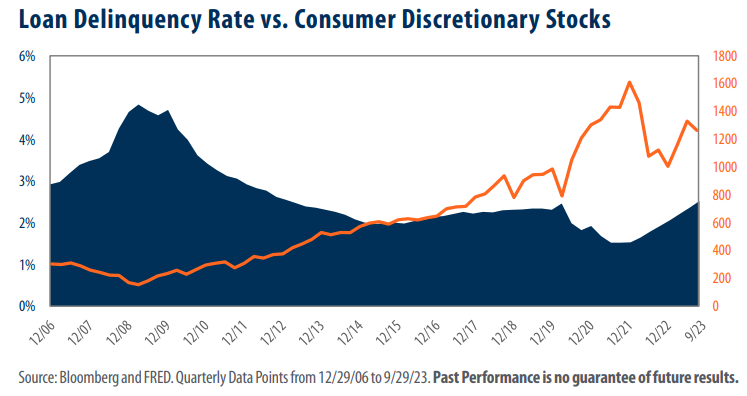
View from the Observation Deck
For today’s post, we thought it would be informative to compare the delinquency rate on consumer loans issued by all U.S. commercial banks to the prices of the S&P 500 Consumer Discretionary Index, over time. We use data from the Board of Governors of the Federal Reserve System, retrieved from FRED, for the former set of observations.
At 42.30%, the S&P 500 Consumer Discretionary Index boasted the third-highest total return of the 11 major sectors that comprise the S&P 500 Index in 2023. The Index has not fared as well in 2024, posting a year-to-date (YTD) total return of 0.03% thru February 13.
In a recent blog post (click here for “Consumer Checkup: Aisle 7”) we wrote about the various factors that could be impacting the performance of the consumer discretionary sector. It is worth restating several of our observations. First, consumer spending appears to have been bolstered by surging U.S. household net worth, which rose to $142.4 trillion at the end of Q3’23, up from $110.1 trillion at the end of Q4’19 (pre-COVID). We also shared insight regarding the “health” of the U.S. consumer as viewed through the lens of their debt burden, noting that a healthy consumer may play an integral role in the U.S. avoiding a protracted recession. As indicated in today’s chart, one measure of consumer health (delinquency rates) shows signs of weakening.
As revealed in today’s chart, after falling to an all-time low of 1.53% in Q3’21, the consumer loan delinquency rate surged to 2.53% in Q3’23. Loan delinquency rates among credit cards and auto loans have risen as well.
One important aspect of overall consumer health is the rate at which they are defaulting on their debt obligations. To be sure, not all delinquencies will become defaults, but a spike in the number of payments that are past-due could be an indication that the U.S. consumer is under increasing financial duress. The loan delinquency rate for credit cards issued by all insured commercial banks stood at 2.98% at the end of Q3’23 (most recent data), its highest level since the close of Q1’12. In addition, the Federal Reserve Bank of New York reported that the percentage of auto loans that moved into serious delinquency (90 days or more delinquent) rose to 2.66% in Q4’23 up from 2.22% over the same period in 2022.
Takeaway
The delinquency rate on consumer loans issued by all U.S. commercial banks stood at 2.53% at the end of Q3’23. While it is true that loan delinquency rates have risen from recent lows, they are not alarmingly high, in our opinion. At current readings, the index reflects delinquency rates that are well below their historical average of 3.07% and even further below their all-time high of 4.85%. That said, the recent surge in delinquencies is notable. We will continue to monitor the delinquency rate among consumers and report back as needed.



